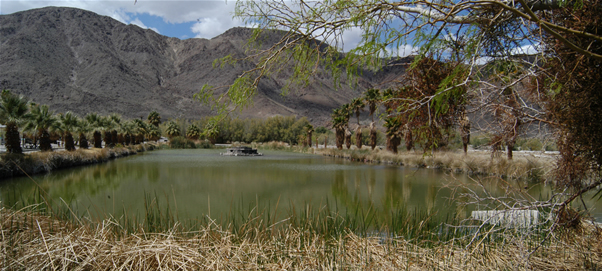Drought Nothing New Here
Desert Studies Center Is in Sixth Year of Drought
October 1, 2007
By Russ Hudson
The very dry season being experienced by the rest of Southern California this year is more or less just the same old thing at the Desert Studies Center in Soda Springs.
“We have been in a drought almost six years now, not counting the abnormally wet year of 2005,” said Robert Fulton, manager and permanent resident of the California State University research facility on Zzyzx Road off Interstate 15. “The last two years, especially, have been extremely dry. We had about 1.5 inches of precipitation in 2006 and less than an inch so far in 2007. The average is 3.5 inches.”
Still not getting a break, the thunderstorms generated during the two September heat waves also missed the center and the area around it, dropping their sometimes torrential rains elsewhere.
“This long drought has affected the plants and animals quite a bit,” said William Presch, center director. “Plants did not flower this past spring, so things are tough. Animal activity is dependent on the plants and water availability, thus many species of plants and animals are stressed and have limited their activities for the year, with some of those animals that hibernate already in hibernation.”
All animals, but especially insects and reptiles, are thinned out, Fulton said, because their reproduction and activity closely follows vegetation growth, particularly annual plants in spring and fall.
“Perhaps most affected plants are the long-lived perennial plants which, although evolved for survival of such dry periods, are largely biding time in a state of some physiological dormancy. Some have dropped their leaves and remained in a suspended state for long periods. Some,” Fulton added, “may not survive this.”
Desert tortoises, which are listed as a threatened species, have had a very short activity period, Fulton said, and likely reduced reproduction rates, “but these are very long-lived animals whose ecology and physiology tolerates these kinds of periods.”
Another endangered species is the Mojave Tui Chub, many of which survive in the ponds around the center. Despite the fact that they are fish living in a drying desert, they may fare better than the other animals. “A Cal State Fullerton geology graduate student has just completed her master’s degree focusing on geohydrology, studying the water sources here at the center,” Fulton said. “The study indicates little reaction to the drought in the aquifers so far.”
The center, located 170 miles from the Cal State Fullerton campus, once was a Native-American campsite, an Army post and a health spa, and now is part of the Bureau of Land Management. A consortium of CSU campuses and the National Park Service manages it. Cal State Fullerton handles administration. Fulton has been the center’s resident manager since 1986.
The Desert Studies Center hosts courses for students from throughout the CSU system and other educational and scientific institutions worldwide, including NASA. There also is a variety of meetings, workshops and symposia, as well as continuing education courses in a variety of topics from astronomy to zoology.


